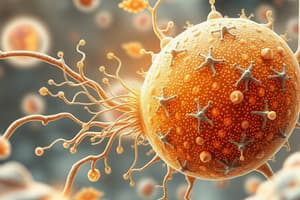Podcast
Questions and Answers
What is the primary function of tight junctions?
What is the primary function of tight junctions?
- Facilitating cell communication through electrical signals
- Providing direct pathways for ion transmission between cells
- Creating a barrier to prevent leakage of substances (correct)
- Anchoring cells to the extracellular matrix
Which type of junction is responsible for the rapid transmission of nerve impulses between cardiac muscle cells?
Which type of junction is responsible for the rapid transmission of nerve impulses between cardiac muscle cells?
- Adherens junction
- Gap junction (correct)
- Desmosome
- Tight junction
What describes the intercellular space in tight junctions?
What describes the intercellular space in tight junctions?
- Broad and filled with plasma proteins
- Non-existent as cells overlap completely
- Variable depending on the tissue type
- Narrow, approximately 15 nm, with an electron-dense material (correct)
What type of modifications are considered basal modifications in epithelial cells?
What type of modifications are considered basal modifications in epithelial cells?
What characterizes adherens junctions in epithelial cells?
What characterizes adherens junctions in epithelial cells?
Which type of junctions are primarily involved in forming anchors between cells?
Which type of junctions are primarily involved in forming anchors between cells?
What is the primary purpose of epithelial polarity?
What is the primary purpose of epithelial polarity?
Which of the following statements about cilia is true?
Which of the following statements about cilia is true?
What typically occurs at the apical surface of epithelial cells?
What typically occurs at the apical surface of epithelial cells?
Which structure forms a supporting layer beneath epithelial cells?
Which structure forms a supporting layer beneath epithelial cells?
Flashcards
Tight junction
Tight junction
A cell junction that forms a tight seal between cells, preventing leakage of fluids and molecules between them.
Adherens junction
Adherens junction
A cell junction that connects cells via anchoring proteins and intermediate filaments, providing structural support and resistance to mechanical stress.
Gap junction
Gap junction
A cell junction that allows direct communication between cells through channels formed by connexins, facilitating rapid passage of ions and small molecules.
Desmosome
Desmosome
Signup and view all the flashcards
Apical modification
Apical modification
Signup and view all the flashcards
Stereocilia
Stereocilia
Signup and view all the flashcards
Cilia
Cilia
Signup and view all the flashcards
Basal infolding
Basal infolding
Signup and view all the flashcards
Basement membrane
Basement membrane
Signup and view all the flashcards
Cell polarity
Cell polarity
Signup and view all the flashcards
Study Notes
Cell Junctions
- Cell junctions are membrane-associated structures that connect and adhere adjacent cells, enabling communication and adhesion.
- There are three main types of intercellular junctions: tight junctions, adherens junctions, and gap junctions.
- Tight junctions create a seal between two adjacent cells, preventing the passage of substances between them. This seal is formed by the fusion of protein strands from each cell.
- Adherens junctions join cells using intercellular material and specific proteins like zonula adherens, creating a connection between them.
- Desmosomes are a type of adherens junction, acting like strong spots of adhesion between cells. The structure includes a thickened region (plaque) on each cell's cytoplasmic surface. Intermediate filaments (like keratin) are inserted into the plaques.
- Gap junctions provide channels between adjacent cells, facilitating the direct passage of ions and small molecules.
- The intercellular space between these cells is narrow (2nm).
- These channels are made of integral proteins in the membrane, arranged side by side.
- The structure of cell junctions is crucial.
- Variations exist in the structure and composition of these junctions, leading to diverse functions. For example, the number and arrangement of proteins influence the properties of these junctions.
- The function of cell junctions is vital, allowing specialized processes like absorption or signaling.
- Specific medical conditions arise from defects in cell adhesion and communication. For instance, defects in tight junctions can impact fetal brain development.
- Epithelial polarity is crucial; it results in cells having distinct apical (top), basal (bottom), and lateral (sides) modifications for specialized functionalities.
- Apical modifications such as microvilli and stereocilia are prominent in tissues like the small intestine, enabling efficient nutrient absorption.
- Basal modifications, such as infoldings in the membrane, increase the cell's surface area, ideal for substances exchange.
- Lateral modifications—junctions—are integral for intercellular communication and interactions.
Studying That Suits You
Use AI to generate personalized quizzes and flashcards to suit your learning preferences.






